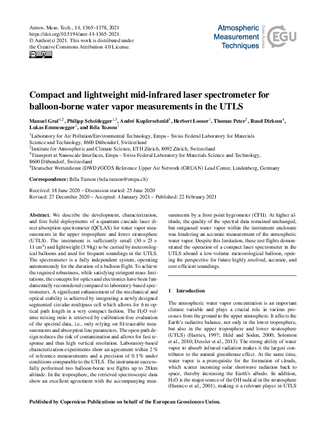We describe the development, characterization, and first field deployments of a quantum cascade laser direct absorption spectrometer (QCLAS) for water vapor measurements in the upper troposphere and lower stratosphere (UTLS). The instrument is sufficiently small (30×23×11cm3) and lightweight (3.9 kg) to be carried by meteorological balloons and used for frequent soundings in the UTLS. The spectrometer is a fully independent system, operating autonomously for the duration of a balloon flight. To achieve the required robustness, while satisfying stringent mass limitations, the concepts for optics and electronics have been fundamentally reconsidered compared to laboratory-based spectrometers. A significant enhancement of the mechanical and optical stability is achieved by integrating a newly designed segmented circular multipass cell which allows for 6 m optical path length in a very compact fashion. The H2O volume mixing ratio is retrieved by calibration-free evaluation of the spectral data, i.e., only relying on SI-traceable measurements and absorption line parameters. The open-path design reduces the risk of contamination and allows for fast response and thus high vertical resolution. Laboratory-based characterization experiments show an agreement within 2 % of reference measurements and a precision of 0.1 % under conditions comparable to the UTLS. The instrument successfully performed two balloon-borne test flights up to 28 km altitude. In the troposphere, the retrieved spectroscopic data show an excellent agreement with the accompanying measurements by a frost point hygrometer (CFH). At higher altitude, the quality of the spectral data remained unchanged, but outgassed water vapor within the instrument enclosure was hindering an accurate measurement of the atmospheric water vapor. Despite this limitation, these test flights demonstrated the operation of a compact laser spectrometer in the UTLS aboard a low-volume meteorological balloon, opening the perspective for future highly resolved, accurate, and cost-efficient soundings.
Title
Compact and lightweight mid-infrared laser spectrometer for balloon-borne water vapor measurements in the UTLS
Authors
Graf, M., Scheidegger, P., Kupferschmid, A., Looser, H., Peter, T., Dirksen, R., Emmenegger, L., and Tuzson, B.
Published
by Atmospheric Measurement Techniques (AMT) at 2021-02-22
Abstract
